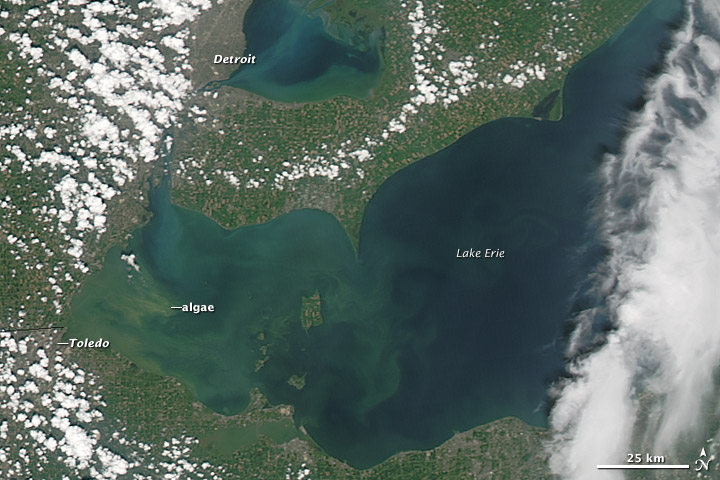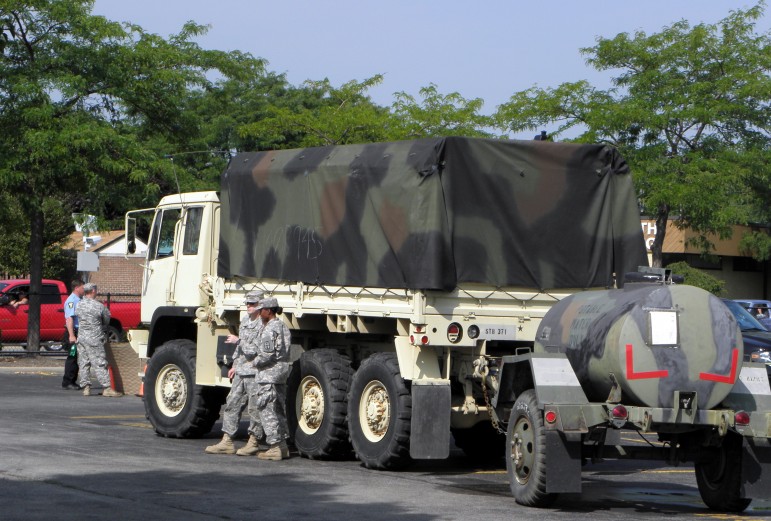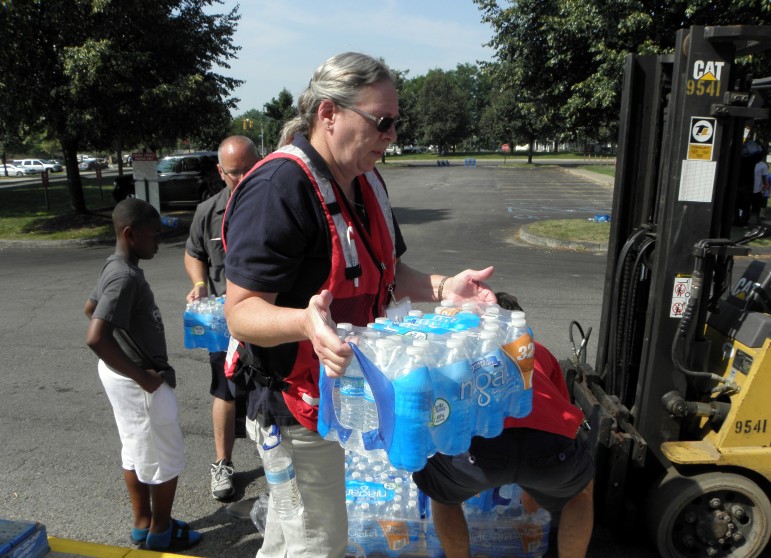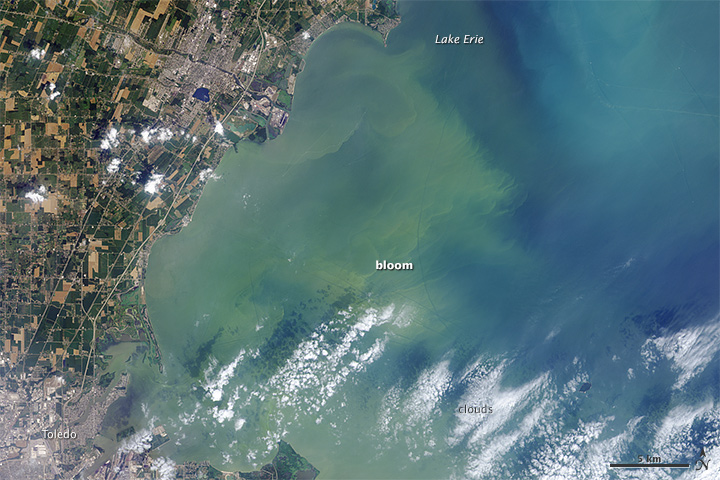
The Moderate Resolution Imaging Spectroradiometer (MODIS) on NASA’s Aqua satellite captured on Aug. 3, 2014 this image, a natural-color view of an algae bloom in the west end of Lake Erie. Image: NASA
INTRO: Toledo public officials yesterday celebrated the end of a nearly 72-hour drinking water ban due to high levels of potentially deadly algae toxins pulled into the Toledo water system from Lake Erie.
But while the toxins have dispersed for now, the threat of another algae-induced water crisis still looms in many northern Ohio communities — and others around the Great Lakes basin. For Great Lakes Echo, Karen Schaefer reports:
SCHAEFER: Toledo Mayor Michael Collins was exuberant as he announced the end of a nearly 3-day standoff with Lake Erie’s now notorious harmful algae blooms After local confirmation of multiple tests by the Ohio EPA, US EPA, and the University of Lake Superior at Sault St. Marie, Mayor Collins decreed his city’s water siege at an end.
COLLINS: We are lifting, in conjunction with the Ohio EPA, the no-drink advisory. Our water is safe…I’m pretty thirsty right now….[applause, under]

Toledo Mayor Michael Collins drains his first glass of tap water in 72 hours, following a citywide drinking water ban due to toxic algae. Image: Karen Schaefer
AMBI: Sounds of water distribution center, under:
SCHAEFER: But while Mayor Collins was lifting a glass of algae toxin-free Toledo tap water to his lips, local residents were still picking up packs of bottled water from distribution centers around the city. At Central Catholic High School on the near west side, the line of cars waiting for water stretched around the block. Chris Bishop, a Toledo auto plant worker, was one of the volunteers passing cases of bottled water through car windows to thirsty Toledo neighbors.
BISHOP: I think it’s going to be a few more days before I trust drinking the water, I think I’m going to have to wait a little while [laughs].
AMBI:Sounds of someone directing traffic at the center, under:
SCHAEFER: Despite viral national news coverage over the last few days, some Toledo residents still seem unclear about why toxic blue-green algae has been burgeoning in Lake Erie. But others, like fellow volunteer Justin Richard, are well aware that fertilizer run-off from farm fields along the Maumee River – which empties into Lake Erie at Toledo — is the scientifically-acknowledged primary culprit for the blooms.
Richard believes Toledo’s drinking water ban was a crisis just waiting to happen – and will likely occur again.

Water ‘buffaloes,’ like this one provided by the Ohio National Guard, kept Toledo residents supplied with drinking water during the recent three-day water crisis. Image: Karen Schaefer
RICHARD: We’ve seen huge algae blooms before and a lot of people are saying that this is going to be a huge issue in the future. Well, I guess the future is now. And it makes me concerned that this is bound to happen again unless we take some immediate action.
SCHAEFER: While celebrating Toledo’s handling of this water crisis, Eric Dgodenski [guh-GIN-ski}, head of environmental health for the city, acknowledged that another algae bloom in the wrong place could easily shut down the city’s water supply a second time.
DGODENSKI: The issue is a chronic issue and it’s going to keep on happening until we address these issues, address these HAB’s. We have to get the funds and resources in here to look at how do we stop it.
SCHAEFER: There’s no question that Toledo’s close call with toxic water has brought an under-reported regional issue to national attention. And that’s important, because according to the National Oceanic and Atmospheric Administration, harmful algae blooms are now a growing threat to public drinking water in all fifty states. Mayor Michael Collins says one his biggest frustrations was trying to assess the safety results of different testing procedures from multiple agencies. Collins believes one of the best things to have come out of his city’s recent water woes is a new agreement on a single method to test for algae toxins.

Toledo residents of all ages volunteered long hours to offer fresh water to thirsty neighbors. Image: Karen Schaefer
COLLINS: We now have, as the result of an agreement with the Ohio EPA, the federal EPA, and in conjunction with our chemists, one simple standard test that will be used across the state of Ohio.
SCHAEFER: That single Ohio test could form the basis for a national standard for algae toxin testing. And that could speed up local decision-making about when public water supplies are once again safe to drink. In the meantime, Great Lakes cities as far away as Chicago and Buffalo are now testing for algae toxins in their drinking water, many for the first time.
And in Toledo, officials here know that they are just a wind shift or a series of rainy summer days away from yet another ban. For Great Lakes Echo, I’m Karen Schaefer.

This closer view of the same area was observed on Aug. 1. 2014, by the Operational Land Imager (OLI) on the Landsat 8 satellite. The OLI image includes a special “coastal blue” wavelength band that allows scientists to adjust for visual distortions caused by the atmosphere near the coast. Image: NASA
Related links:
- NOAA: What are the dangers of harmful algae?
- World Health Organization: Water-related diseases, cyanobacteria
- Northeast Ohio Regional Sewer District: Toledo’s “Do not drink” order should be a wake-up call
- Related news stories